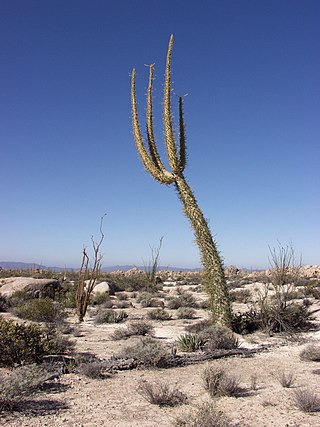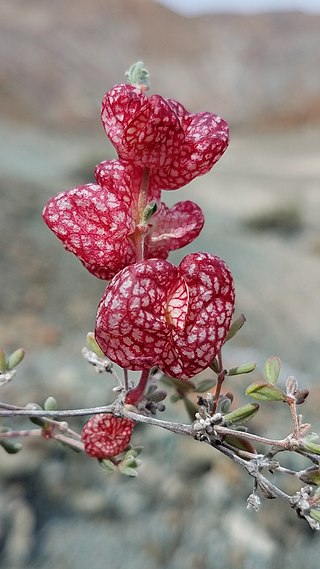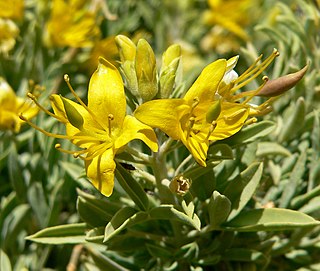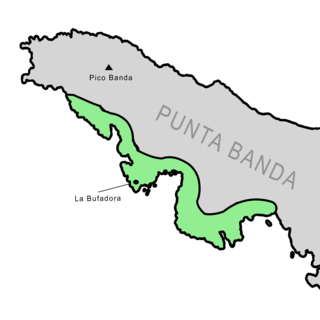
Fouquieria columnaris, the Boojum tree or cirio is a tree in the ocotillo family,(Fouquieriaceae) whose other members include the ocotillos. Some taxonomists place it in the separate genus Idria. It is nearly endemic to the Baja California Peninsula, with only a small population in the Sierra Bacha of Sonora, Mexico. The plant's English name, Boojum, was given by Godfrey Sykes of the Desert Laboratory in Tucson, Arizona and is taken from Lewis Carroll's poem "The Hunting of the Snark".

Fuchsia is a genus of flowering plants that consists mostly of shrubs or small trees. The first to be scientifically described, Fuchsia triphylla, was discovered on the Caribbean island of Hispaniola about 1696–1697 by the French Minim monk and botanist, Charles Plumier, during his third expedition to the Greater Antilles. He named the new genus after German botanist Leonhart Fuchs (1501–1566).

Ornithostaphylos is a monotypic plant genus which contains the single species Ornithostaphylos oppositifolia, commonly known as the Baja California birdbush or Baja California manzanita. A large, evergreen shrub in the heather family, this species is near-endemic to northwestern Baja California, with a small population just north of the border in San Ysidro, California. It produces a much-branched inflorescence of white, urn-shaped flowers, and has leathery leaves that appear opposite or in whorls. These characteristics separate it from its close relatives in the region, which include manzanitas (Arctostaphylos), summer holly (Comarostaphylis) and mission manzanita (Xylococcus).

Harfordia macroptera is a woody perennial in the family Polygonaceae commonly known as rabbit's purse. It is the sole species in the genus Harfordia, which is endemic to the Baja California Peninsula. This plant is characterized by a unique, conspicuous bladder embellished with red to purple veins that surround the fruit. The sac-like structure is actually a dramatically modified bract, and assists in dispersal of the seeds through the wind.

Calochortus albus is a species in the genus Calochortus in the family Liliaceae. It is also known by the common names fairy lantern, white fairy lantern, pink fairy lantern, lantern of the fairies, globe lily, white globe lily, white globe-tulip, alabaster tulip, Indian bells,satin bells, snowy lily-bell, and snow drops.

Cleomella arboreasyn. Peritoma arborea, is a perennial shrub or bush in the spiderflower family (Cleomaceae) known by the common names bladderpod, bladderpod spiderflower and burro-fat. It has yellow flowers in bloom all months of the year. It emits a foul odor to discourage herbivory from insects.

Pachycormus is a monotypic genus of flowering plants in the cashew family commonly known as the Baja elephant tree, torote blanco, or copalquín. The single species Pachycormus discolor is endemic to the Baja California peninsula, with three varieties. This sarcocaulescent tree or shrub is characterized by its unique gnarled growth habit, skin-like exfoliating bark, and succulent nature, whose appearance has been colorfully described as "the proboscis of an elephant holding a nosegay," a "huge radish protruding from the ground," or "grotesque resemblances of the flexed limbs of a corpulent human being." This drought-deciduous species spends most of the year dormant, but following rains pinnate green leaves emerge, and in the late spring to summer the leaves yellow, fall, and give way to bright red, cream, or pink flowers that give it a striking appearance in bloom.

Camissoniopsis bistorta is a species of flowering plant in the evening primrose family known by the common names southern suncup and California suncup. It is native to southern California and Baja California, where it grows in several types of plant community along the coast and in the coastal hills and mountain ranges. This is a hairy annual or short-lived perennial herb spreading from a basal rosette, with stems reaching up to 80 centimeters long. The leaves are narrow and sometimes toothed, and 1 to 12 centimeters in length. Toward the end of the spreading stems are nodding inflorescences of flowers, each flower with four bright yellow petals dotted with red at their bases.

Salvia brandegeei is a perennial evergreen shrub in the mint family known by the common names Santa Rosa Island sage or Brandegee's sage. It is a fragrant plant characterized by lavender flowers and dark green leaves. For many years, it was thought to be native only to Santa Rosa Island, one of the Channel Islands of California, until it was discovered along the coast of Baja California. It is threatened by development and mining along the mainland portions of its range, but otherwise has a stable population on Santa Rosa Island.

Dudleya attenuata is a species of perennial succulent plant known by the common name taper-tip liveforever, native to Baja California and a small portion of California. A rosette-forming leaf succulent, it has narrow pencil shaped leaves that can often be found covered in a white epicuticular wax. The thin, sprawling stems branch to form the clusters of rosettes, with plants creating a "clump" up to 40 cm wide. The small flowers are white or yellow, with 5 spreading petals. It is a diverse, variable species that extends from the southernmost coast of San Diego County to an area slightly north of the Vizcaino Desert, hybridizing with many other species of Dudleya in its range. Some plants with white or pinkish flowers were referred to as Orcutt's liveforever, referring to a former subspecies split on the basis of the flower color.

Dudleya gatesii, known by the common name as Gates'liveforever, is a species of perennial succulent plant in the family Crassulaceae. It is native to the central desert of the Baja California peninsula, found growing along dry and rocky outcroppings. It is characterized by red inflorescences topped with white flowers, bracts that are often reflexed downwards, and a rosette of dark-green leaves turning reddish.

Dudleya campanulata is a species of perennial succulent plant known by the common name as the Punta Banda liveforever, native to Baja California and endemic to the Punta Banda peninsula, a promontory south of Ensenada that encloses the southern limit of the Bahía de Todos Santos, a deepwater bay. One of many species of Dudleya native to the peninsula and surrounding islands, it is distinguished by its campanulate flowers and its occupation of a narrow habitat that consists of ocean bluffs on the southern end of the Punta Banda, near the well-known blowhole La Bufadora.

Dudleya pachyphytum is an insular succulent plant known by the common name Cedros Island liveforever. It is a member of the genus Dudleya, in the family Crassulaceae. Characterized by thick, blunt leaves covered in a white, powdery wax and adorned by white flowers in bloom, it is regarded as one of the most attractive and charismatic members of its genus. It is endemic to the foggy northern end of Mexico's Cedros Island, occupying an ecological niche shared with the Cedros Island Pine.
Dudleya formosa, known by the common name La Misión liveforever, is a species of perennial succulent plant endemic to the Guadalupe Valley in Baja California. It is characterized by bright green leaves, red floral stems, and pink flowers.

Fraxinus parryi, known by common names chaparral ash, crucecilla, and fresnillo, is a species of ash native to southwestern North America, growing as a shrub or a small tree.

Jatropha moranii is a very rare subshrub in the genus Jatropha known commonly as Moran's lomboy. This species in the family Euphorbiaceae is endemic to a small area of Cabo San Lucas in Baja California Sur. It is characterized by a succulent stem and branches, along with a distinct woody caudex, and attractive white flowers.

Lysiloma candidum, most commonly known as the palo blanco, is a tree of the family Fabaceae near-endemic to the Baja California Peninsula in Mexico. It may grow to a height of 10 metres (33 ft) and is one of the few spineless woody legumes in the region. It has compound leaves with oval gray-green leaflets. The creamy-white, globose clusters of flowers bloom in March through May and perfume the air with a light, spicy fragrance. The flowers are followed by red-brown pods up to 15 centimetres (5.9 in) long that hang delicately on the thin branches. This species is distributed throughout the Baja California Peninsula, from Rancho El Barril in southern Baja California state to the Cape region of Baja California Sur, and is also very rarely found in the state of Sonora.

Lepechinia hastata is a rare species of perennial shrub in the mint family commonly known as the Cape pitcher sage or Baja pitcher sage. Lepechinia hastata is an aromatic shrub characterized by large, arrowhead-shaped leaves and attractive purple to magenta flowers. In the wild, it is known from the forested mountains of the Sierra de la Laguna in Baja California Sur and the volcanic Socorro Island in the Pacific Ocean, both part of Mexico. The plants of Socorro Island are their own subspecies, and differ in their white flowers and wooly, grayer foliage.

Ruellia californica is a species of flowering plant in the Acanthus family commonly known as the rama parda or flor del campo. This evergreen shrub is native to the Baja California peninsula and neighboring coastal Sonora. It is characterized by showy, funnelform blue-purple flowers that bloom throughout the year. There are two subspecies, one endemic to Baja California Sur, and they primarily differ in their presence or absence of hairs on their foliage. This plant is cultivated as an ornamental, and is used to provide a colorful accent to desert and dry gardens.

Gambelia juncea is a species of flowering shrub in the plantain family commonly known as the Baja California bush snapdragon or Baja bush snapdragon. Gambelia juncea is a highly variable woody perennial to 1 m (3.3 ft) characterized by long, arching, reed-like stems and showy, bright red, two-lipped tubular flowers. Native to the Baja California peninsula and coastal Sonora, this species is widespread in the region across numerous habitats and has several varieties. It was formerly placed in the primarily South American genus Galvezia, but taxonomic studies have supported the reclassification of the two North American species into Gambelia. This species, with a number of cultivars, is widely used as an ornamental shrub for xeriscaping, erosion control, native plant gardens, and wildlife gardens.



















